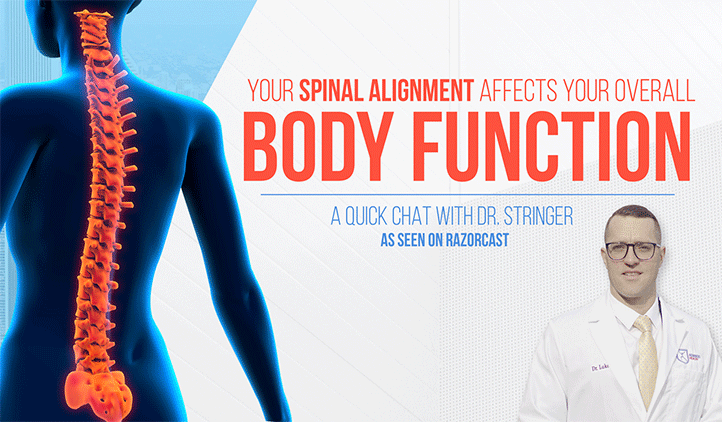Your spinal alignment essentially dictates pretty much everything that goes on within the spine. Over 80% of your extremities, both the tissue and the joints, anchor into your spine. You have two types of your skeletal system. You have your axial spine, which is your physical spine, neck, upper to mid back, low back, sacrum, your tailbone, and your pelvis. And you have your appendicular spine, which is everything else, shoulder joints, elbow joints, hips, and knees. In order for your appendicular spine, or extremities to be in alignment and moving well, your actual spine has to be in alignment.
For example, you should have a 40-degree curve in your lower back. Somebody who has a 60-degree curve is going to start to transfer weight disproportionately into the tailbone and the hips, which can create subluxations, or misalignments in the tailbone and the hips. Now imagine going for a run with your tailbone and your hips out of alignment. Well, that’s going to create a compensatory issue. Muscles are going to have to work harder for joints that are out of alignment, and it’s going to affect how the hip, possibly the knee, the foot, and the ankle are being loaded. So, when you are putting repetitive stress into those joints and they’re not moving well, it is going to break down the joints and the tissues and you will have a cascading effect.
Alignment of your spine can affect a myriad of things, including how we feel and how we function. When our spine is out of alignment, it puts us in a chronic state of stress. When we’re chronically stressed, it can increase cortisol production within the body that in turn blocks hormone reception, increases our blood sugar, because we can’t absorb the blood sugar, so then essentially our homeostatic state is not in sync.
Your spine houses your nervous system, and the nervous system controls everything we do. 15% percent of your nervous system is sensory, so it emits pain. 85% of your nervous system is asensory. If a nerve is under pressure, that part of the nerve that’s sensory may give you neck pain, but 85% of that nerve within the neck partially innervates the thyroid. Thyroid innervates sleep, mood, energy levels, and metabolism. If the nerves that innervate the thyroid, or at least partially innervate the thyroid, are under tension from poor alignment, then we can also have those lifestyle diseases that we see a lot of with our corporate athletes here: poor sleep, poor mood, poor energy levels, poor metabolism.
When your neck is in good alignment, you should have the top bone in your neck meet the bottom bone, it should have a roughly 42-degree curve and it ties the weight of the head evenly into the joints and the tissue. But now imagine that the top bone has shifted two inches in front of your bottom bone, and then we’ve lost 50% of that neck curve. New research is coming out in the Nature Journal that the curve in your neck directly correlates to how well your spinal cord functions in terms of the synapse. So, let’s imagine you’re a professional footballer, you’re a wide receiver, and you have that visual stimulus, and your neck’s out of alignment. You’re going to process that stimulus slower than someone who has a spine that’s in alignment. That is going to affect performance.
If our spine is out of alignment while we are young, and it hasn’t been addressed, then the chance for pain greatly increases due to the biomechanical stress and tension we’ve got to the joint and the tissue. The younger we are, the less time, energy, and effort we’re going to have to spend on correcting something, compared to the older we are when eventually it will break down. Spines out of alignment over time degenerate more quickly than spines that are in alignment. The degeneration is pain and dysfunction and something that we want to be putting off for as long as we can.
Having your spinal alignment checked now is paramount for how we feel and function today, but also is going to make sure that we age naturally instead of through an accelerated process, through degenerative changes, issues in the discs, and compensatory patterns within the joints. A chiropractor should be able to shoot a set of full spinal films in the front and the side, and then analyze those films to check that your spine is within alignment. If we have an aligned spine, good biomechanical function, and no pressure on the nervous system we should be able to function optimally.

